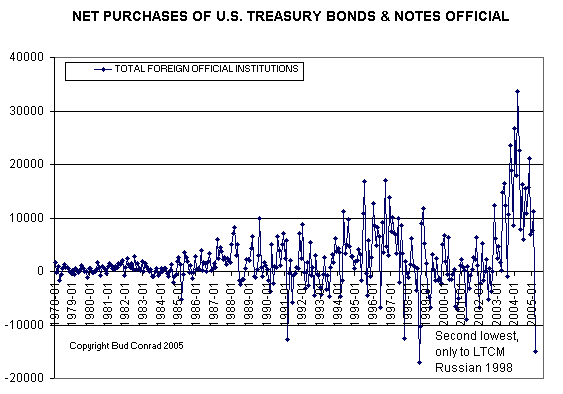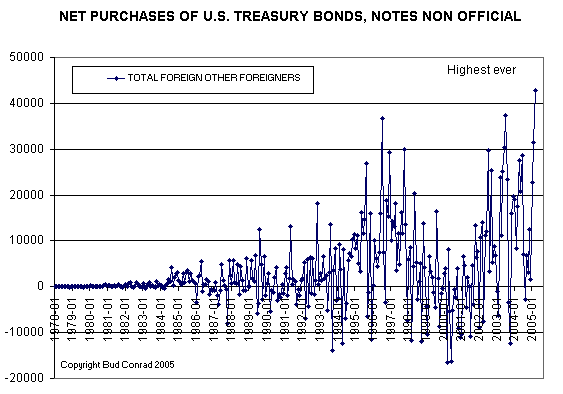Japan and China Stop Buying US Debt
I have been analyzing interest rates because they can affect all of our investments. The lynchpin to the projection of US rates is how foreigners handle our US trade deficit, which is often described as “unsustainable”. This article examines the latest data to see how the cross-border flows of capital may affect rates, which will in turn affect our economic system.
Under a resource-based gold convertible dollar system, as we had for most of our nation’s history, the kinds of trade deficits we now are faced with could not occur. When trade imbalances occurred, delivering gold to make up the difference would balance the books. As gold was drained from a deficit country, the currency would be devalued, making imports too expensive, and thus stopping the trade deficit. But in a fiat-dollar-based system, these limits are removed.
To see how far we have come from such a gold-based system, just look at the size of the current imbalance: the US government claims to have about 261Moz of gold, which is worth about $110B at today’s market prices. Our annual trade deficit is running about $660B per year. Using gold to pay off this trade imbalance, the entire stash would be gone in 2 months. And that assumes the gold on our books is really there and that accounting is accurate -- there has been no audit in decades.
As a relative size comparison note, the Federal Reserve has issued $755B of paper money called Federal Reserve notes. If this currency were backed by gold at 100%, the gold price would be $2,892. From the above we see that the US is in no position to return to a gold standard anytime soon, despite protestations by many of us that we need a more reliable store of value than Fed paper.
We need to understand how this new system has worked so well for the US. The counter parties to our trade deficit have managed the system to allow this extreme condition to continue. At the risk of oversimplification, what they are doing is providing a massive Vendor Finance program for their exports. They literally loan us the money to buy their goods. They have been doing this for decades, but have expanded greatly as we have expanded our high living by purchasing so much with our paper currency.
This is patently “unsustainable” because at some point foreigners may decide they have enough of our dollars, forcing the whole system to fall apart. The dollar would devalue, and then we wouldn’t be able to buy as many things as we want from foreigners, like energy to drive our cars. But this feared calamity has not occurred. The US dollar has dropped some but stabilized, and US interest rates are not soaring. The system may appear stretched, but nothing has broken, so we have been lulled into believing that it may not really be a problem.
Some argue that catastrophe can’t happen. These optimists point out that the foreigners who have loaned us the dollars to maintain our life style, are freely doing so and are now locked in a deadly embrace where they would hurt themselves if they don't continue extending us credit. (I‘m not so sure, but I’ll get to that later.) They go on to point out that the situation is almost like the Mutual Assured Destruction of the cold war, where the Soviets and the US were deterred by the prospect of world destruction; neither side would initiate all-out attack on the other, because the result would be worse for everyone.
The problem for the Japanese and Chinese is that they hold so much of our debt that if they tried to cash it in (sell off their holding of US Treasuries) they would drive Treasuries down, interest rates up, the dollar down and be left holding big losses on their balance sheets. The proponents of this status quo like to talk about how owing the bank $100 is my problem, but owing the bank $1 million becomes the bank’s problem. Again, I question that conclusion.
Let’s look at the numbers: Japan has $700B of accumulated Treasuries, and China $200B. They could afford to let them crumble to worthlessness because these levels of losses could be absorbed by these economies. On a relative basis the damage to the US would be worse. That is not a likely course, but it should be providing fear as an overhang to the value of the dollar. It is more likely that they will keep the flow supported at some level because they want to continue to keep their workforce busy producing goods for us for trade. That is a bigger deterrent to their pulling out of the vendor finance program than the potential loss on their Treasury holdings.
All that background is to set the stage as to why looking at the details of this imbalance of trade is so important. The imbalance has not produced disaster because of how the foreigners have handled our deficits. So key to predicting the future is to determine if there is any change in the Vendor Financing policies of our foreign partners. So, I now turn to reading the tea leaves of the latest cross-border flows to see what is unfolding.
China, Japan, India, and Korea have all made comments that they may need to consider re-balancing their portfolio of foreign assets. By this they mean decreasing the percentage of their holdings denominated in dollars. Despite these pronouncements, the dollar has held up well in the last 5 months. The highest level question is whether foreign reinvestment is keeping up with our purchases. So far investment is continuing.
The first chart below shows that total cross border investment flow is still strong. It shows foreign long-term investments of foreigners buying our Treasuries, Agencies, corporate bonds and equities, minus our purchases of their bonds and equities. In March there is a slowing from $90B to $45B but with trade deficits around $50B to $60B this does not appear alarming, as several months of being over the trade level has left a balance between these flows.

But we need to look at the components of the figures to see if there are underlying causes for worry. First, are the biggest acquirers of our government debt, China and Japan, still continuing to do so? Here is a picture of purchases of Treasuries since the beginning of 2005 by the biggest holders:

The surprise here is that China and Japan are doing what they said they would do, even selling off some of their holdings. If Japan and China are not buying the government debt, who is? The little islands of the Caribbean stand out. Obviously, they are not wealthy nations with the wherewithal to buy such quantities for their own natives. They are acting on behalf of investors from other nations who are passing money through the banks of the Caribbean to make their purchases. Unfortunately, the US Treasury is unable to capture the true source of this money since they only know the first party of their transactions. The most cynical observers offer a theory that the US government itself might be behind these offshore operations in an attempt to prop up the dollar. They have no evidence, and we are unlikely to ever know.
Another component of the expansion of purchases of US Treasuries is that London has purchased large amounts of our debt. This includes British investment, but I suspect that a large percentage of this flow is indirectly from other countries using London money center banks to make transactions for them. In this case I look to OPEC countries using London as their broker to recycle increased oil revenues.
There is another shift in the composition of the purchases of Treasuries: Central Banks are buying less and the rest of the public is buying more. In the month of March the central banks actually sold off $15B from their holdings, which was the second highest rate ever. The only bigger month was during the Russian default and the LTCM collapse of August 1998. This shift is also consistent with the halt in Chinese and Japanese purchases, as they use official institutions to carry out their actions.

The other component is purchases by non-official sources, which were at a record:

Here are a couple of other observations: US purchases of foreign stocks were close to a high at $14.4B, reflecting US attitude becoming more positive for foreign investments. This is growing just as foreigners have slowed their buying of US stocks from the time of our stock bubble. The combination is an additional headwind for cross-border balance.

Separately and inexplicably, Norway cut its holdings of Treasuries in half to $16.9B from $33.8B, without any news to explain their actions.
What does all this mean? These details do not yet constitute cause for immediate alarm. The US was able to attract foreign investment from the Caribbean and London to cover the loss of support from Japan and China. I expect future deficits to continue to be large as the dollar stays weak and foreign purchases continue. But I question the strength of the structure of the Vendor Financing as described here. I see a shift in the composition of foreign purchases that looks to be built on a less stable base.
Who these Caribbean investors really are is a mystery. To give some explanation, one could imagine US hedge funds using these instruments as offshore conduits. They could ply their trade of leverage to attain positions of safety in the face of plight for concern about risks of already-too-low rates being offered for junk and emerging debt. But hedge fund rumors of calamity don’t leave me with comfort that this is a reliable source of deficit funding.
The London money center may be funneling OPEC oil money that would gain more anonymity and protection from possible asset freezes by the US, as was done with Iran when politics turned confrontational. My conclusion is to read these tea leaves as saying that the hands holding our Treasuries look weaker and less committed in the long-term than the traditional Japanese and Chinese central bank holders. I consider it a weakening of underpinning, not yet a break. The only sure comment is that this bears continued watching.
Copyright Bud Conrad and Macronalysis
May 2005
















